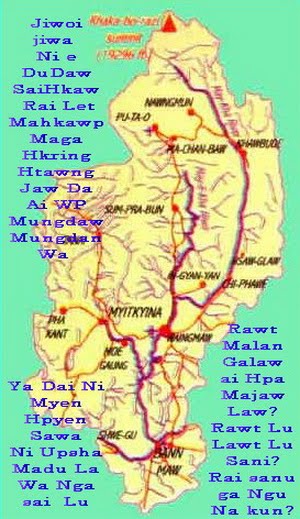By MARWAAN MACAN-MARKAR / IPS WRITER
BANGKOK — When Southeast Asian foreign ministers gather in Hanoi this week for a series of annual security meetings, the region’s most troublesome member, military- ruled Burma, is due to come under scrutiny over reports of its nuclear ambitions.
Alarm bells have been going off in South-east Asian capitals since the early June expose by the Democratic Voice of Burma (DVB), an Oslo-based broadcasting station run by Burmese journalists in exile that reported that the Burmese junta intends to build nuclear weapons facilities.
Indonesia, the largest country in the 10-member Association of Southeast Asian Nations (Asean), is among those expected to seek an explanation from Burma during the meetings in the Vietnamese capital, which run from Jul. 20- 23.
"Jakarta is concerned about this issue," a South-east Asian diplomatic source told IPS.
Burma, also known as Myanmar, is expected to face similar queries from the Philippines, which in May had an envoy, Libran Cabactulan, chair the 2010 Review Conference of the Nuclear Non-Proliferation Treaty at the UN headquarters in New York.
At that review meeting, Cabactulan urged delegates to work towards the treaty’s common goals: disarmament, non-proliferation of nuclear weapons and the right to peaceful use of nuclear technology.
The treaty, which entered into force in 1970, remains the cornerstone for building a global nuclear non-proliferation regime.
Asean, whose members include Brunei, Cambodia, Laos, Malaysia, Singapore and Thailand in addition to Burma, Indonesia, Philippines and Vietnam, itself has a nuclear weapons-free zone agreement.
The Southeast Asian Nuclear-Weapon-Free Zone Treaty came into force in 1997, the same year Burma became an Asean member and started to benefit from regional protection against international criticism for the junta’s oppressive rule. Burma signed the regional nuclear weapons moratorium treaty at a 1995 meeting in Bangkok.
Against the backdrop of reports of Burma’s nuclear plans, the Asean prohibition on building and storing nuclear weapons now faces a serious challenge. "The issue will be raised at this meeting even though the concrete evidence may be hard to find," said Kavi Chongkittavorn, a columnist on regional affairs for Thailand’s English-language daily ‘The Nation’. This is about intention and motive."
According to media reports, US Secretary of State Hilary Clinton, who will be in Hanoi to join her Asean counterparts in a broader security forum, is likewise expected to seek clarification about Burma’s nuclear intentions. Washington has also expressed concern about Burma’s close links to North Korea, which has faced sanctions imposed by the UN Security Council since June last year.
UN Security Council Resolution 1874, adopted in the aftermath of an underground nuclear test by North Korea, also calls on UN members to search North Korean cargo ships, but Burma has not adhered to this.
In fact, the DVB’s investigative report ‘Burma’s Nuclear Ambitions’ pointed to Burmese-North Korean collaboration in building a network of tunnels for military purposes in the secretive Southeast Asian nation.
The report has already prompted the Vienna-based International Atomic Energy Authority (IAEA) to send a formal letter of inquiry from the junta, which denied the DVB’s findings. The Burmese regime has also issued two more formal statements denying it has any nuclear ambitions.
But little of that has turned the heat off the regime’s back. Experts in the field have entered the fray, arguing that ‘Burma’s nuclear ambition is apparently real and alarming’, as the headline of one commentary recently published in ‘The Nation’ argued.
"Although Burma’s pursuit of nuclear weapons has long been rumored, the (DVB) documentary contains new information from a recent defector who provided DVB with photographs, documents and a view from inside the secretive military that should finally put to rest any doubt about Burma’s nuclear ambition," wrote Robert Kelly, a recently retired director of the IAEA, in that commentary.
"The evidence includes chemical processing equipment for converting uranium compounds into forms for enrichment, reactors and bombs," Kelly added. "Taken altogether in Burma’s covert program, they have but one use—nuclear weapons."
Asean’s latest troubles with Burma come on top of mounting pressure from Western nations and human rights groups for it to urge the junta to enable a free and fair general election it has promised to hold this year.
Asean is already grappling with the plight of tens of thousands of refugees from Burma who have fled the country due to the army’s campaign against separatist rebel groups, as well as the nearly two million undocumented migrant workers who have left their country’s crumbling economy.
Jul 20, 2010
Subscribe to:
Post Comments (Atom)
WUNPAWNG MUNGDAN SHANGLAWT HPUNG A NINGGAWN MUNGMASA
WUNPAWNG MUNGDAN SHANGLAWT HPUNG A NINGGAWN MUNGMASA
CHYE JU KABA SAI
Sa Du N'Gun Jaw La ai Majaw N'chying wa Chyeju Dum Ga ai,Yawng a Ntsa Wa Karai Kasang Kaw na N'Htum N'Wai ai Shaman Chye ju Tut e Hkam La Lu Nga mu Ga law







No comments:
Post a Comment